Some rechargeable lithium battery chemistries need more TLC than others when it comes to safety precautions.
TOM BLAHA, MEMORY PROTECTION DEVICES
RECHARGEABLE BATTERY TECHNOLOGY has come a long way, continually boosting performance with fewer annoying memory effects that severely limited the useful operating life of earlier generation cells.
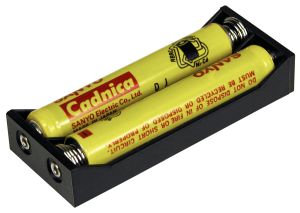
The most common rechargeable battery chemistries commercially in use include nickel cadmium (NiCd), nickel-metal hydride (NiMH), lead acid, lithium ion (Li-ion), lithium ion polymer (Li-ion polymer), and reusable alkaline cells.
NiCd batteries suffer from low energy density (45-80 Wh/kg) but deliver long life and high continuous discharge rates. These cells contain toxic materials. Common NiCd applications include two-way radios, biomedical equipment, video cameras, and power tools.
NiMH cells feature higher energy density (60-120 Wh/kg) but a shorter operating life. These cells contain no toxic materials. Common NiMH applications include mobile phones and laptops.
Lead-acid batteries have a low energy density (30-50 WH/kg), which is acceptable for large equipment where the added size and weight are often not critically important. These applications include automobiles, wheelchairs, emergency lighting, and uninterruptible power supplies (UPS).
Lithium-ion (li-ion) chemistry has become widely used for delivering relatively high energy density (100-130 Wh/kg) that aids in miniaturizing products. Consumer grade Li-ion batteries can operate for approximately five years and 500 full recharge cycles. Industrial grade Li-ion batteries can operate for up to 20 years and 5,000 recharge cycles and feature an extended temperature range.
Li-ion polymer batteries present this chemistry in an ultra slim form factor that is a good candidate for low-profile applications such as notebook computers and cell phones.
Reusable alkaline batteries have an initial energy density of 80 Wh/kg and help to address the growing environmental challenge surrounding alkaline battery disposal. Alkaline rechargeable batteries have severe performance limitations, including a short lifespan and the ability only to be recharged to 50% of their initial capacity.
When deciding among these various chemistries, design engineers must review such parameters as battery life, load qualities, self-discharge, and initial price versus long-term cost of ownership. Invariably, the battery specification process involves some form of compromise that balances the strengths and weaknesses of each chemistry.
Lithium-ion battery safety
Despite the growing use of Li-ion batteries, their safe operation requires vigilance. Designing for max battery runtime requires packing more active materials into each cell, forcing the separator to become thinner. Too many microscopic particles converging on one spot can cause a short circuit, resulting in a sizable flow of current between the positive and negative plates. This action could result in thermal runaway, where one failing cell begins a chain reaction that compromises surrounding cells. For this reason, Li-ion battery packs often incorporate dividers to protect adjacent cells.
There are two common types of lithium-ion chemistry: cobalt and manganese (spinel). Manganese offers superior thermal stability, sustaining temperatures of up to 250°C (482°F) before becoming unstable. Cobalt cells feature a low internal resistance, thus delivering higher current on-demand for power tools and medical devices. The trade-off is lower energy density, as a cathode made of pure manganese offers about half the capacity of cobalt.
Li-ion batteries often mix the two metals, then provide a safety margin by limiting the amount of active materials and by including three additional levels of safety protection: an electronic protection circuit (PTC) that inhibits high current surges; a circuit interrupt device (CID) that opens the electrical path if an excessively high charge voltage raises the internal cell pressure to 10 Bar (150 psi); and a safety vent that allows a controlled release of gas in case of a rapid rise in cell pressure.
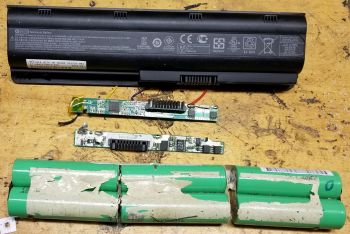
The typical PTC contains a solid-state switch that automatically switches on if the charge voltage reaches 4.30 V. A fuse also cuts the current flow if the skin temperature of the cell approaches 90°C (194°F). To prevent the battery from over-discharging, a control circuit cuts off the current path at approximately 2.5 V/cell. A patented printed circuit board (PCB) can offer added safety protection by limiting the voltage range from 2.5-4.25 V.
Under normal circumstances, a Li-ion battery will simply power down in the event of a short circuit. However, certain defects such as microscopic metal particle contamination may go undetected, in which case the PTC may not be able to stop the thermal runaway once it begins.
Other notable safety concerns involve static electricity or poorly made battery chargers that can destroy the PTC, causing the solid-state switch to remain stuck in the on position without the user’s knowledge. Another potential concern is cold temperature charging, as consumer grade Li-ion batteries cannot be charged below 0°C (32°F). Although they may appear to be charging normally, metallic lithium can plate onto the anode while on a sub-freezing charge, and the plating is permanent and cannot be removed.
If done repeatedly, such damage can compromise the safety of the pack. The battery will become even more vulnerable to failure if subjected to impact, crush, or high-rate charging. By contrast, industrial grade Li-ion batteries can be recharged and discharged at extremely cold temperatures.
Choosing a battery holder
Battery holders can accommodate the extended length of a cylindrical cell with a built-in PTC. For example, standard battery holders are available to securely hold between one and four 18650 Li-ion cells, with similar holders available for other widely used sizes. Custom battery holders are also available that can accommodate circuit protect modules (CPMs) that are not integrated into
the battery.
Problems often arise when hobbyists try to assemble their own battery packs without considering battery safety. For example, consumers often manipulate cell phone batteries to extend their operating life, sometimes with devastating results. For this reason, most laptops contain embedded code that only permits the use of an OEM-approved battery pack.
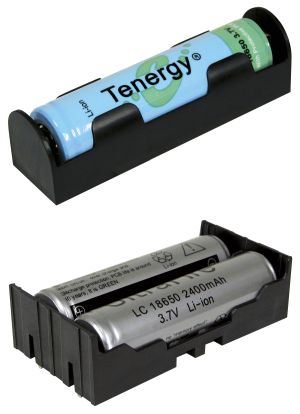
Design engineers and procurement professionals must be wary about specifying inferior-quality Li-ion batteries that could contain high levels of impurities, lack a properly designed or manufactured PTC, or omit other time-proven safeguards. Battery safety is a growing concern, especially for airplane travel. So be cautious and always specify a reputable brand of Li-ion battery with built-in PTC protection, then secure it with the right battery holder.
Cylindrical-shaped rechargeable Li-ion batteries come in various sizes, including ½ AA, AAAA, AAA, AA, A, B, C, Sub-C, D, F, N, A23, A27, BA5800, Duplex, and 4SR44. Rechargeable Li-ion cylindrical cells are designed to be slightly larger than Alkaline batteries to accommodate the internal protection circuitry that prevents over-discharging and short-circuit damage.
Button cells and coins cells have a distinctive disc-like shape that is usually wider in comparison to height. The most common type of coin cell is the CR2032 Li-ion cell. Li-ion polymer cells are constructed with a series of flat layers to maintain a low profile and typically require the use of a wire harness instead of positive and negative terminals.
All rechargeable cells can be configured into battery packs that combine multiple cells into a self-contained unit.
The choice of battery chemistry, the size and shape of the cell, and the size and packaging of the device all dictate the need for a battery holder. Standard battery holders are available for virtually every type of rechargeable battery, including cylindrical cells, rectangular batteries, coin cells, button cells, and many common battery packs. Custom battery holders are also available to meet specific application requirements.
It is critical to choose a battery holder that properly secures the battery against shock and vibration, thus ensuring a rugged and reliable electrical connection.
The shape and packaging of the device, the space available for the battery, and special requirements for miniaturization can impact the choice of battery holder. If the application involves exposure to harsh environments, including extreme heat and humidity, the battery holder must be constructed from materials that can endure such extreme conditions. For example, gold-plated contacts are highly recommended to provide greater corrosion resistance for battery holders used in hot, humid climates.
Application-specific requirements will dictate the ideal rechargeable battery and its accompanying battery holder.

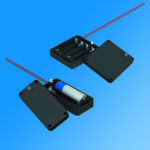

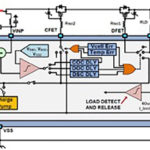



Leave a Reply